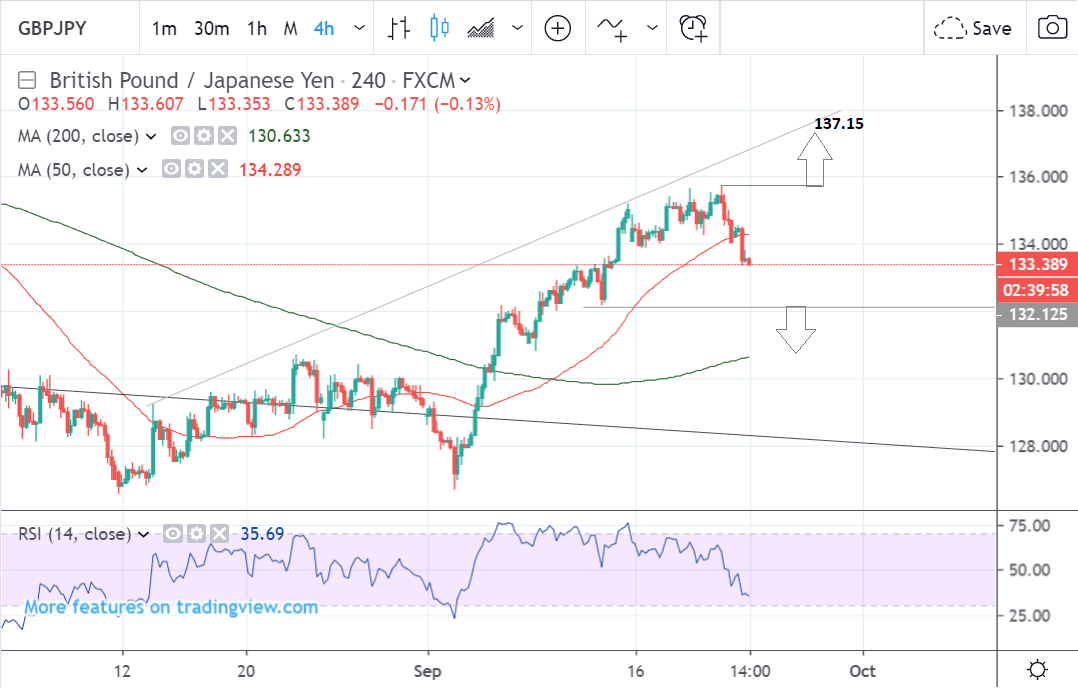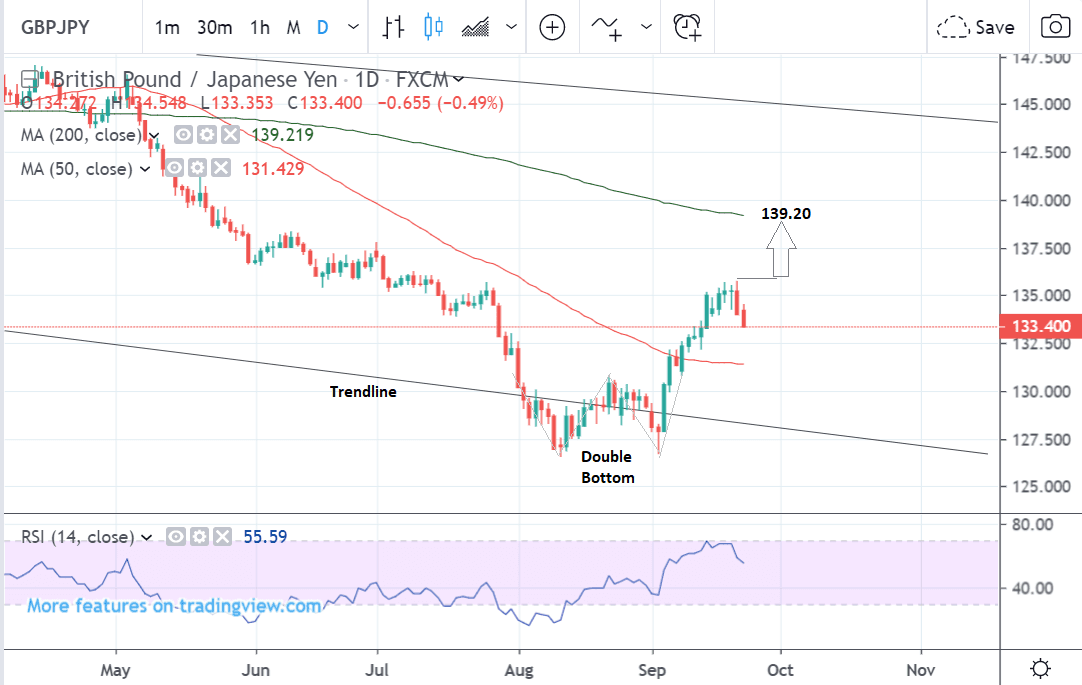Pound-Yen Rate's Pullback hasn't Killed the Trend

Image © Adobe Stock
- GBP/JPY in short-term uptrend after basing
- More upside likely on condition highs are breached
- Yen to be driven by risk trends and Tokyo inflation
The Pound-to-Yen exchange rate is trading at around 133.39 at the start of the new week, after rising 0.74% in the week before, and studies of the charts suggest there is an upside bias and the trend is likely to continue higher.
The 4 hour chart - used to determine the short-term outlook, which includes the coming week or next 5 days - shows the pair rising in a new sequence of peaks and troughs higher ever since basing at the September 3 lows.
Although it has pulled back recently, a break above the 135.75 highs would provide confirmation of a continuation up to a target at 137.15.
Likewise, a break below the 132.16 September 12 lows would be a major warning of a bearish reversal lower and the onset of a more negative outlook for the pair.
The daily chart shows the pair in a steep rally ever since forming a double bottom reversal pattern at the early September lows.
Despite currently pulling back, the pair's uptrend is more likely to continue than not given the old adage ‘the trend is your friend’.
The chart includes the next bullish target at 139.20, the level of the 200-day moving average (MA); this is subject to a break above the 135.75 high.
The daily chart is used to give an indication of the outlook for the medium-term, defined as the next week to a month ahead.
The weekly chart shows the pair pulling back after the steep recovery of the last few weeks.
Last week it formed a bearish ‘gravestone doji’ candlestick and if this week is also negative that will provide yet more confirmation of a short-term reversal in the trend.
At the same time, however, a break above the top of the doji candlestick would negate the negative indication and suggest an elongation of the new uptrend higher to a target at circa 140.000.
The weekly chart is used to give us an indication of the outlook for the long-term, defined as the next few months.
The Japanese Yen: What to Watch
The main drivers of the Japanese Yen are global risk appetite trends, September inflation figures in Tokyo and the release of the minutes of the last Bank of Japan (BOJ) meeting midweek.
The Yen acts like a safe-haven currency which rises when there are global crises and falls when conditions stabilise. Overall risk appetite is, therefore, an important driver of the currency.
Risk appetite is currently quite low after poor PMI data in Germany and Europe raised concerns about the scope of the global manufacturing slowdown. Slightly better data from the U.S, on Monday afternoon, however, helped offset the negative data from the Eurozone - nevertheless the Yen remains supported.
The outlook for U.S.-China trade talks remains cautious after President Trump said he wanted a "complete deal" not an interim deal with some agricultural purchases added on.
It is UN summit week in New York which suggests world leaders will be more open to diplomacy and tact - something potentially negative for the Yen.
Tokyo inflation data for September is forecast to show a 0.6% rise when it is released at 00.30 BST on Friday morning. This would be slightly below the 0.7% previous print and potentially reinforce expectations the BOJ might be about to loosen monetary policy to help drive up inflation. Core Tokyo CPI is also out at the same time and has food and fuel inflation stripped out. The Tokyo inflation rate always precedes and provides a taster of national inflation.
The other key release are the minutes from the August BOJ monetary policy meeting. This could provide insights into what members of the board think about the economy and future BOJ policy. If there are signs they might be in favour of further monetary easing that could be negative for the Yen.
Looser, or easier, monetary policy from a central bank usually devalues the local currency by increasing liquidity and reducing interest rates.
Higher liquidity increases supply and lower interest rates weaken by reducing net foreign capital inflows since investors tend to be more attracted to jurisdictions that offer higher returns.
Time to move your money? Get 3-5% more currency than your bank would offer by using the services of foreign exchange specialists at RationalFX. A specialist broker can deliver you an exchange rate closer to the real market rate, thereby saving you substantial quantities of currency. Find out more here. * Advertisement


